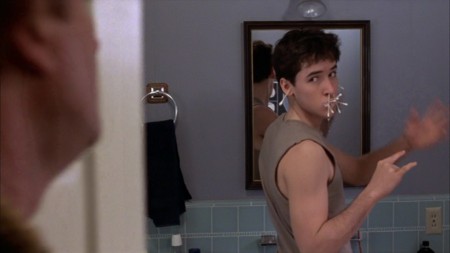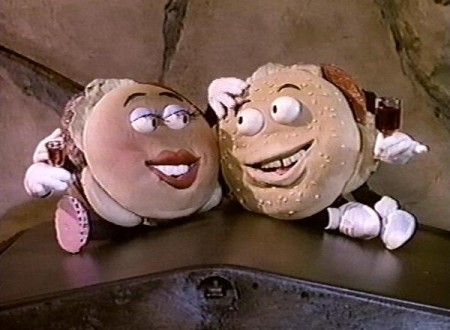Strange Moments in Solid Movies: Better Off Dead Burger
Better Off Dead is one of the best high school comedies about the absurdity of adolescence. It presents a myriad of predicaments that could conceivably mire a typical student’s well-being–mental, familiar, financial, social, and sexual, just to name a few–and runs wild with them all for the express purpose of laying waste to the insecurities and hang-ups that concern most people during this weird time in life. Every romantic hiccup is exaggerated to disastrous dimensions; every apparent shortcoming is tantamount to total deficiency. In turn, most of these problems that might trouble a young person are revealed to be completely laughable when they are properly framed for bizarre effect: anything this ridiculous and cartoonish should not be taken seriously, and issues even remotely similar to them should, as a result, become less world-crushing. When it can’t get any worse, it can only get better, and Better Off Dead is leaps and bounds funnier than many other comedies because it’s more than willing to go to some humiliating and hilarious lows before its protagonist ascends the proverbial mountain in the end.
From the get-go, things aren’t particularly hot in the life of Lane “I cannot do it” Meyer (John Cusack). The one-two punch of not making the Greendale High ski team and getting dumped by his girlfriend Beth of six months (or, in highschoolese, forever) is overwhelming, especially since both failures stem from Roy Stalin, sole ski judge and stealer of significant others. Excessively confident and perfectly named, Stalin is everything that Lane isn’t, which ought to be a good thing except this is high school we’re talking about, where the alpha dog is oftentimes the social omega. Stalin has the teenage trifecta of surface successes: he’s popular, good looking, and drives a nice car. And if that weren’t enough (which it usually is), he’s also the only person to have skied from the glacier of the imposing K-12 and survived. Stalin and his reputation loom over Lane like the K-12 itself, making the protagonist feel smaller and smaller by comparison (and, to top it all off, Stalin’s stuffed teddy bear is way bigger than Lane’s).
Of course, Stalin isn’t the only force at work that makes Lane feel insecure about who he is and what he has to offer. His home life is relentlessly awry. His parents are an embarrassing twosome: while Lane’s father is completely out of touch (he reads ridiculous books to find a way to communicate with his son), his mother is simply touched. They have no ability to understand what Lane is going through. His younger brother, seemingly capable of doing anything he puts his mind to, spends his free time mastering the fine arts of picking up trashy women and building fully-functioning laser guns and spaceships. And outside the home isn’t much better, either. His top-hat wearing best friend, though optimistic and encouraging, is essentially a lovable burnout. And his geometry class (taught by the imitable Vincent Schiavelli) is comprised almost entirely of math enthusiasts, all of whom go nuts for epic homework assignments and exhaustive discussions that leave Lane reeling. He just can’t keep up with all the work.
All of these dynamics would be a little more navigable if they weren’t compounded by other self-esteem-crippling incidents that level him to near flat-line status. Throughout the movie, Lane has a tough time moving on because his life is persistently punctuated by other ridiculous dilemmas that don’t just come and go; they have numerous callbacks and variations, slightly adjusted but equally debilitating. Whether it’s putting up with other men (his math teacher, his mailman, and Barney Rubble) trying to woo his ex, a two-dollar obsessed paper boy chasing him down ceaselessly, or a duo of Asian street-racing students inspired by Wide World of Sports and Howard Cosell that invariably leads to car crashes, Lane consistently feels cornered, with no way out, which eventually contribute to another recurrence: attempted suicides. And even those are botched by his own ineptitude and the obliviousness of others. Nothing is in the bag for Lane, not even death.
However, in this seemingly endless string of farcical failures (and I realize this write-up has been quite the catalog of mishaps), there is still one strange moment in the movie that stands out: the Frankenstein-esque (re)animation of a Van Halen-rocking hamburger and his hamburgette. Take a look (because my last sentence will make zero sense if you don’t):
On his first day at Pig Burgers, Lane cannot focus on work; the reality of the occupation–cooking gross burgers for an even grosser employer (with whom Lane has a great rapport, seeing as how he has already had two traffic collisions with him)–is dispiriting. So Lane does the only rationale thing at this dead-end job: he uses his imagination to make a burger come alive and rock out. And, powered by Van Halen’s “Everybody Wants Some”, the sequence ends up being a boisterous appeal for some good ol’ fashioned love and affection–things that Lane (and indeed everybody) looks for.
What’s particular unique about this moment is that it’s thoroughly positive and upbeat (well, until it ends, that is). Previously, negativity drove the daydreaming. Or, perhaps even worse, just when Lane was feeling a little better, the negativity would set in because he just couldn’t keep thoughts of insecurity out of his mind. At one point, trying to quash his heartache, Lane draws a picture of a monster eating Stalin as a horrified Beth looks on, but the animated Beth quickly chastises him for not only making the “sick” drawing, she also denigrates him for being a spaz and having no game. Lane just can’t win, even in his own artwork and imagination. But in this reverie, Lane is in total control; he is the one who makes the burger come alive; he chooses the song that the burger will enliven (as opposed to the song “Better Off Dead” that plays previously, a song that essentially chooses death over independence from a loved one). And, most significantly, he will see that his own creation can entice the hamburgette with its killer playing and unquestionable sex appeal. Lane has indeed created a monster, a monster that has some self-confidence and playfulness. And, little by little, this internal victory will carry over into the real world.
This step in the right direction didn’t come out of nowhere. Moments before this sequence, Lane meets Monique, a French exchange student who lives next door to him. Meeting her has helped him to begin to move on. And, unlike the other humiliating callbacks, the hamburger and hamburgette get their own one later in the film when Lane and Monique have a romantic evening together and Lane rocks out with some smooth saxwork of his own. The Van Halen hamburger is no longer just alive; it is now alive in him.
Now, the “Everybody Wants Some” sequence is only a small step to be sure (especially since he battles depression and suicidal tendencies a bit later, as well), but it’s an affirmative step, one that embraces life and creativity instead of death and destruction. Because of this step, he can move forward and find success and happiness. Instead of crashing his crummy car, with the help of Monique, he’s going to fix his dormant Camaro and beat the street racers. Rather than skiing the K-12 with thoughts of death dancing in the back of his head, he skis with a sense of urgency that truly shows what he has to offer (note: still not two dollars). And by the end, when he’s won the day and the girl, everyone indeed wants some of Lane. But, more importantly, Lane now knows what he himself wants and he knows how to get it the right way–the Van Halen hamburger way.





